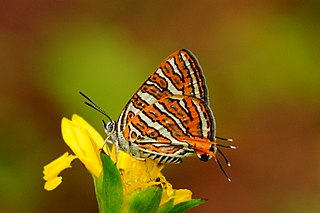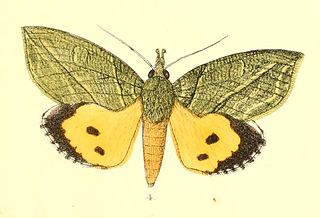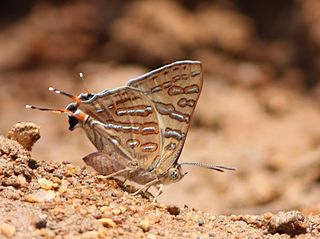Related Research Articles

Bindahara phocides, the plane, is a small butterfly found Indomalayan and Australasian realms that belongs to the lycaenids or blues family.

Hypolimnas misippus, the Danaid eggfly, mimic, or diadem, is a widespread species of nymphalid butterfly. It is well known for polymorphism and mimicry. Males are blackish with distinctive white spots that are fringed in blue. Females are in multiple forms that include male-like forms while others closely resemble the toxic butterflies Danaus chrysippus and Danaus plexippus.

Cigaritis vulcanus, the common silverline, is a species of lycaenid or blue butterfly found in Asia. It was first described by Johan Christian Fabricius in 1775.

Zesius chrysomallus, the redspot, is a species of lycaenid or blue butterfly found in Sri Lanka and India.

Horaga onyx, the common onyx, is a species of lycaenid or blue butterfly found in Asia.

Hypolycaena nilgirica, the Nilgiri tit, is an uncommon species of lycaenid or blue butterfly found in Asia, especially in the lowland regions to mid-hills of India and Sri Lanka.

Deudorix perse, the large guava blue, is a species of lycaenid or blue butterfly found in the Indomalayan realm. It was described by William Chapman Hewitson in 1863. The larva feeds on Randia dumetorum.

Zeltus is a butterfly genus in the family Lycaenidae, the blues. It is monotypic containing the species Zeltus amasa, the fluffy tit, a small butterfly found in Indomalayan realm. The butterfly is found in India, specially the Western Ghats, Sikkim to Assam. It can also be found in Myanmar, Thailand, West Malaysia, Sumatra, Borneo, Java and the Philippines.

Creon is a monotypic butterfly genus in the family Lycaenidae. Its sole species is Creon cleobis, the broadtail royal, which is found in South Asia.

Eudocima hypermnestra is a moth of the family Erebidae described by Pieter Cramer in 1780. It is found in China, Thailand, Taiwan, India and Sri Lanka.

Lichenaula lichenea is a species of moth of the family Xyloryctidae. It is known in Australia from the Australian Capital Territory, New South Wales and Queensland.

Pycnarmon alboflavalis is a moth in the family Crambidae. It was described by Frederic Moore in 1888. It is found in India and Bhutan.
Syllepte cometa is a moth in the family Crambidae. It was described by William Warren in 1896. It is found in Assam, India.
Nordstromia humerata is a moth in the family Drepanidae. It was described by Warren in 1896. It is found in north-eastern India.
Gogana abnormalis is a moth in the family Drepanidae first described by Warren in 1897. It is found on Borneo, Sumatra and Peninsular Malaysia.
Euchaetis endoleuca is a moth in the family Oecophoridae. It was described by Edward Meyrick in 1888. It is found in Australia, where it has been recorded from South Australia and Western Australia.
Garrha costimacula is a moth in the family Oecophoridae. It was described by Edward Meyrick in 1883. It is found in Australia, where it has been recorded from Queensland and New South Wales.
Lichenaula melanoleuca is a moth in the family Xyloryctidae. It was described by Turner in 1898. It is found in Australia, where it has been recorded from New South Wales and Queensland.
Hypertropha thesaurella is a moth in the family Depressariidae. It was described by Edward Meyrick in 1880. It is found in Australia, where it has been recorded from Queensland and New South Wales.

The Common shot silverline, Cigaritis ictis, is a species of lycaenid butterflies. It is native to India and Sri Lanka. The Sri Lankan population is classified as a subspecies: Cigaritis ictis ceylonica(Felder, 1868).
References
- ↑ Nuss, M.; et al. (2003–2017). "GlobIZ search". Global Information System on Pyraloidea. Retrieved March 1, 2018.CS1 maint: discouraged parameter (link)
- ↑ BOLD Systems
- ↑ Warren, W. (1896). "New Species of Pyralidae from the Khasia Hills". The Annals and Magazine of Natural History: Including Zoology, Botany, and Geology. 6. Taylor & Francis. 18: 169 – via Internet Archive.